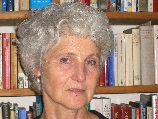Day 3 :
- Cancer and Tumor Immunobiology | Autoimmunity and Therapathies | Clinical and Cellular Immunology
Location: Salmanca

Chair
Thomas Boldicke
Helmholtz Centre for Infection Research, Germany
Session Introduction
Roswitha Gropp
Hospital of Ludwig-Maximilians-University, Germany
Title: Loss of immunological tolerance as a driving force of infl ammation in the NSG-UC mouse model of ulcerative colitis
Time : 10:00-10:30

Biography:
Roswitha Gropp has over 25 years of experience in preclinical development and infl ammatory diseases. She recently took on a different view considering the infl ammatory process in UC as an uncontrolled wound healing process. This hypothesis assumes that epithelial damage induces the release of signals to evoke a Th2 characterized infl ammatory response that ultimately results in repair of the colon. Using agent based modeling fi rst disease maps were developed to describe the infl ammatory milieu and the dynamics of the infl ammatory response. This approach together with immunological profi ling of patients allows for a better understanding of underlying mechanisms ultimately leading to individualized therapies.
Abstract:
To date, no comprehensive analysis of autoantibodies in sera of patients with ulcerative colitis has been conducted. To analyse the spectrum of autoantibodies serum-IgG from UC patients and non-UC donors were screened by using a human protein microarray. Screening yielded a remarkable number of 697 diff erentially reactive antigens, most of which are expressed on immune cells suggesting a general lack of tolerance in a subgroup of UC patients. From this analysis, CD99 emerged as a biomarker to discriminate between non-UC and UC patients. In vitro, incubation with CD99 induced the frequencies of CCR4 expressing CD4+ cells (eff ector memory regulatory T cells) and TSLPR expressing CD11b+ macrophages and CD14+ monocytes in peripheral blood mononuclear cells (PBMC), indicating an anti-infl ammatory response. In vivo, challenge with CD99 aggravated disease symptoms and pathological phenotype in NOD-scid IL2Rï§null (NSG) mice reconstituted with PBMC from UC donors and challenged with ethanol (NSG-UC) indicating failure to induce tolerance in this mouse model. Treatment with sirolimus, which is known to promote Treg suppressed infl ammation as indicated by decreased clinical and histological scores and IFN mRNA levels and increased frequencies of eff ector memory regulatory T-cells. In contrast, treatment with an anti-CCR4 antibody resulted in depletion of CCR4 expressing CD4+ T-cells and aggravated infl ammation. Th us, autoimmunity seems to be a driving force in the NSG-UC mouse model. Future studies have to show whether this also applies to the human disease and whether shift ing the immunological equilibrium towards tolerance might be a promising therapeutic alternative.
Thomas Böldicke
Helmholtz Centre for Infection Research, Germany
Title: ER Intrabodies against the polysialyltransferases ST8SiaII and ST8SiaIV inhibit polysialylation of NCAM in rhabdomyosarcoma tumor cells
Time : 10:30-11:00

Biography:
Thomas Böldicke has obtained his PhD degree from Max Planck Institute of Molecular Genetics, Berlin. Since 1986, he has been working at Helmholtz Centre for Infection Research, as a Project Leader of Intracellular Antibodies
Abstract:
Polysialic acid (polySia) is a carbohydrate modifi cation of the neural cell adhesion molecule (NCAM), which is implicated in neural diff erentiation and plays an important role in tumor development and metastasis. Polysialylation of NCAM is mediated by two Golgi-resident polysialyltransferases (polyST) ST8SiaII and ST8SiaIV. Intracellular antibodies (intrabodies; IB) expressed inside the ER and retaining proteins passing the ER such as cell surface receptors or secretory proteins provide an effi cient means of protein knockdown. To inhibit the function of ST8SiaII and ST8SiaIV specifi c ER IBs were generated starting from two corresponding hybridoma clones. Both IBs αST8SiaII-IB and αST8SiaIV-IB were constructed in the scFv format and their functions characterized in vitro and in vivo. Stable expression of ST8SiaII-IB, ST8SiaIV-IB and luciferase in the rhabdomyosarcoma cell line TE671 reduced cell surface expression of polySia and delayed tumor growth if intrabody expressing tumor cells were xenograft ed into C57BL/6J RAG-2 mice. Data obtained strongly indicate that αST8SiaII-IB and αST8SiaIV-IB are promising experimental tools to analyze the individual role of the two enzymes during brain development and during migration and proliferation of tumor cells.
Dong-Kyu Kim
Hallym University College of Medicine, South Korea
Title: Cross-talk between human mast cells and epithelial cells by IgE-mediated periostin production in eosinophilic nasal polyps
Time : 11:20-11:50

Biography:
Dong-Kyu Kim, MD, PhD, is working as an Assistant Professor at the Department of Otorhinolaryngology-Head and Neck Surgery and Nano-Bio Regenerative Medical Institute, Hallym University, College of Medicine, Chuncheon, Korea.
Abstract:
Background: Periostin is involved in Th2 inflammation and a biomarker of allergic diseases. However, its role in chronic rhinosinusitis with nasal polyps (CRSwNP) remains unclear.
Objective: To investigate the cellular origin and the role of periostin in CRSwNP.
Methods: Expressions of periostin and its receptor, integrin αV, were investigated in nasal polyps (NP) by qRT-PCR, IHC and ELISA. Immunohistochemistry and immunocytochemistry were used to determine cellular sources of periostin in NP and a human mast cell line, LAD2. LAD2 cells were stimulated with IgE, IL-4, IL-13 or TNF-α and periostin measured in the culture supernatants. Normal human bronchial epithelial cell (NHBE) were stimulated with periostin, IL-4, IL-13, TNF-α, and dsRNA alone or in combination and thymic stromal lymphopoietin (TSLP) measured in the culture supernatants.
Results: Periostin was up-regulated and positively correlated with IL-5, CCL-11 and CT scores in eosinophilic NP (E-NP), but not in non-eosinophilic NP. Tryptase-positive cells were a main source of periostin in E-NP. Periostin levels were also correlated positively with total IgE in E-NP homogenate. Furthermore, IgE stimulation enhanced the mRNA and protein levels of periostin. Confocal microscopic examination of LAD2 cells showed that periostin was localized in the granules. Overexpression of integrin αV was observed in epithelial layers of E-NP and correlated positively with the levels of periostin in E-NP. Periostin and integrin αV expressions in the epithelia were positively associated with TSLP at mRNA and protein levels in E-NP. Treatment with periostin induced more TSLP production in NHBE than those without periostin, in combination with IL-13 or IL-4 and TNF-α or dsRNA.
Conclusion: These data suggest that periostin is upregulated in E-NP and correlates with Th2 markers. Human mast cells are a major source of NP-derived periostin, which may induce TSLP production from epithelial cells.
Alexandra Emelyanova
The Institute of General Pathology and Pathophysiology, Moscow
Title: Released-active antibodies are innovative products for the effective management of severe respiratory viral infections
Time : 11:50-12:20

Biography:
Emelyanova A G graduated from M V Lomonosov Moscow State University, Russia, with qualification in Pharmacy. She is currently pursuing her PhD on Pharmacology and Preclinical Studies Organization and Conduction at Institute of General Pathology and Pathophysiology, Russia. She has published manuscripts devoted to research in viral infections treatment in English and Russian reputed journals and participated in international conferences and congresses.
Abstract:
Statement of the Problem: Viral respiratory infections represent one of the main threats to human health. Antibodies-based therapy is a modern trend for combating viral infections, restricted by challenging administration and manufacturing. Our entirely new approach is to use antibodies (Abs) to immune regulators in a specific technological form, capable of surmounting these drawbacks. We found that after the initial Abs substance gradual consequent concentration’ decrease a specific activity releases (released-activity-RA) which is not to directly neutralize the target, but to modify it, e.g., RA Abs to IFNg and RA Abs to CD4 stimulate non-specific and specific immunity, while RA Abs to histamine influence anti-inflammatory network. These Abs’ use demonstrated efficacy in experimental studies of major viral respiratory infections.
Methodology & Theoretical Orientation: RA Abs to IFNg were evaluated by using standard models of influenza A/H1N1pdm09 (Oseltamivir resistant and sensitive strain), MERS-HCoV and RSV/Long infections in vitro; and in complex with RA Abs to histamine and RA Abs to CD4 against influenza A/H3N2 infection in vivo.
Findings: RA Abs have shown anti-influenza effect against its seasonal and pandemic strains, 2 times increasing the survival, and 10 times lowering virus titer (p<0.05) in vivo; enhancing Oseltamivir antiviral effect (in combination with RA Abs), decreasing viral copies number (Oseltamivir-sensitive strain) >100 times vs. Oseltamivir alone (p<0.05) in vitro. For the resistant strain Oseltamivir showed no effect alone, but in combination with RA Abs-a significant (>1000 times, p<0.05) virus titer decrease was found.
Conclusion & Significance: our fundamentally new approach to Abs’ therapeutic use not only offers an opportunity to safely and effectively treat a wide spectrum of infections even the most dangerous, but also to increase the existing drugs’ efficacy via their conjoin application with RA Abs.
Yanina H Arana P
Bernhard Nocht Institute for Tropical Medicine (BNITM), Germany
Title: Role of co-inhibitory pathways during experimental infection by Trypanosoma cruzi tulahuen strain.
Time : 12:20-12:50

Biography:
Yanina Arana has been involved in the study of several infectious diseases that are considered public health problems in many Latin American countries. By her interest in science, she has participated in different research projects showing compromise, autonomy and valuable analytical skills that allowed to her to lead a research group in Cysticercosis in collaboration with other national and international professionals in this disease. Her expertise in several methodologies, leadership, objectivity and criticism has been reflected in her publications. Currently, she develops her doctoral thesis project at the BNITM focusing in the evaluation of regulatory pathways during the Trypanosoma cruzi infection. This experience, allow her to obtain valuable theoretical knowledge and practical skills that will be of benefit for the continuity of her research in her institution in Peru as a member of a group that have the aim to form researchers that contribute to the solution of health problems that affect this country.
Abstract:
Statement of the Problem: The protozoa parasite Trypanosoma cruzi is the etiological agent of Chagas disease or American trypanosomiasis. Nearly 18 million people in Latin America and 90 million worldwide are at risk of infection. To establish life-long infections which are often asymptomatic or with digestive or cardiac alterations that can lead to host death, T. cruzi must subvert the host immune system employing several strategies that involve effectors and regulatory mechanisms. Preliminary studies have shown that during chronic parasite infections, Ag-specific T cells become dysfunctional, upregulate the expression of inhibitory receptors, involving these regulatory pathways in the control of the infection. Recent studies have shown that T. cruzi modulates the expression of these receptors on lymphocytes after the infection however, there are a variety of natural strains of T. cruzi and it appears that their immune modulatory effects are strain-dependent, a feature that may influence parasite-host interaction. The aim of this study is to evaluate the role of two inhibitory pathways: BTLA:HVEM and PD-1:PD-L1 during the experimental infection by T. cruzi Tulahuen strain in a murine model, focusing on the effects of a blockade of these pathways as a potential strategy to design future therapeutic approaches for Chagas disease. Methodology & Theoretical Orientation: Knockout mice for these inhibitory molecules were employed in a previously established infection model. The immune response was evaluated by flow cytometry and cytokine analysis by cytometric bead assays. Findings: BTLA and PD-1-deficiency was not associated with a reduced parasitemia neither improved resistance to infection. No difference in the frequency of activated T cells or other immune cells populations were observed in both groups of infected knockout mice in comparison to control groups, however reduced levels of cytokines (IL-2, IL-6 and IL-9) were observed in both infected knockout mice. Strikingly, upon PD-1:PD-L1 blockade, upregulation of another inhibitory receptor (Tim-3) were observed on activated T cells. Conclusion & Significance: In vivo assays demonstrated that these inhibitory pathways might play an important role in the control of parasite during infection. The interruption of these pathways could not improve the resistance to the infection but favored a pronounced exhaustion stage of immune cells suggesting a compensatory mechanism, specifically upon PD-1:PD-L1 blockade that induced the upregulation of another inhibitory receptor (Tim-3) during the infection, mechanism that have been reported to be involved in the anti PD-1 therapy resistance in several cancers.
Audrey Margery-Muir
Curtin University, Western Australia
Title: Anti-C1q antibody concentrations by ELISA in systemic lupus erythematosus
Time : 12:50-13:20

Biography:
Audrey Margery-Muir is a PhD student at Curtin University (Perth, Western Australia) in the school of Biomedical Sciences. She has been researching the immune pathways involved in the pathology of SLE and has had 3 successful papers accepted/ published in well renowned papers. She is enjoying her research and hope to continue forward after the completion of her doctorate degree.
Abstract:
Systemic lupus erythematosus (SLE) is an inflammatory disorder in which autoantibodies contribute to impaired apoptosis and clearance of cell debris. Anti dsDNA and anti C1q antibodies have been implicated, as well as complement protein C1q itself. IgG autoantibodies reacting with the collagen-like region of C1q protein (aC1q ab) were quantitated in serum of 56 patients diagnosed with SLE and undergoing treatment for variable periods, together with 33 age/sex-matched controls. Analysis of the results showed optimal sensitivity and specificity of 57% and 91% respectively at a cut-off concentration for positivity of 20 U/ml. The assay is a potentially useful confirmatory test for SLE, but is not suitable as a screening test for SLE with the probability of a positive test and SLE in an individual within a random population of only ≤1%. aC1q ab concentrations were detectable in all samples tested with concentrations manifesting no correlation with age and serum C1q levels in SLE patients and a negative correlation with age in controls. The aC1q ab detected by this assay do not react therefore with native C1q. In SLE patients, aC1q ab concentrations correlated with the concentrations of dsDNA antibodies, (p = 0.0001) and C-reactive protein and inversely with complement component C4 (C4) concentrations (p = 0.041). aC1q ab concentrations were not associated with individual therapeutic regimens, but were higher in those patients receiving a combination of three drug therapies and with the presence of renal disease. The diagnostic relevance of this complex autoantibody will require further definition of its antigenic specificities.
Closing Ceremony
